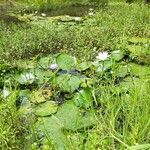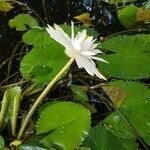Rhizomes branched or unbranched, erect, ovoid; stolons slender. Leaves: petiole sparsely to densely puberulent. Leaf blade abaxially purplish, adaxially green, nearly orbiculate, to ca. 3 × 3 dm, margins spinose-dentate; venation radiate and prominent centrally, without weblike pattern, principal veins ca. 15; surfaces abaxially sparsely to densely puberulent. Flowers emersed, 12-25 cm diam., opening nocturnally, many flowers not closing until late morning, only sepals and outermost petals in distinct whorls of 4; sepals abaxially uniformly green, prominently veined, lines of insertion on receptacle not prominent; petals 16-20, white; stamens ca. 75, yellow, outer with connective appendage projecting less than 2 mm beyond anther; filaments widest below middle, slightly shorter to longer than anthers; pistil ca. 20(-30)-locular, appendages at margin of stigmatic disk linear, 6-12 mm. Seeds ellipsoid, 1.4-1.8 × 0.9-1.2 mm, ca. 1.5-1.6 times as long as broad, with longitudinal ridges bearing papillae 20-150 µm.
Leaves 10–32 x 11–28 cm., coriaceous, orbicular or suborbicular, incised-cordate, somewhat peltate, lobes nearly closed or slightly overlapping, margin ± repand, dentate-mucronate, teeth formed by the convergence at the margin of (2) 3 nerves, upper surface smooth, under surface prominently nerved to the edge, primary lateral nerves 7–9 on each side of the midrib, forking dichotomously 3–4 times and not themselves forming a closed reticulation, secondary nerves 7–9 pairs arising from the midrib.
A waterlily. It is a herb which grows in water. It grows 10-40 cm high and spreads 0.9-3.5 m wide. The stem or rhizome is stuck in the mud. The leaf stalks and flower stalks arise directly from this root. The leaves swim on the surface of the water. The leaves are toothed around the edge. The flowers are reddish and white. They are large and with 12-14 pointed petals. There are 4 fleshy outer segments of deep green.
Aquatic herb. Leaves repand, dentate-mucronate by protrusion at margin of convergent prominent nerves. Flowers white.
Petals c. 20, the outermost as long as the sepals, oblong or oblong-lanceolate, rounded or acute at the apex.
Flowers white or cream, 10–18 cm. in diam., peduncle stout, glabrous (in specimens from our area).
Sepals 4, 4.5–9 x 2–3.5 cm., ovate-oblong or oblong-lanceolate, obtuse.
Stamens 40–60; anthers obtuse, without prolongation of the connective.
Petals white; flowers open from early evening until late morning.
Seeds 1.2 mm. long, ellipsoid, with longitudinal lines of hairs.
Carpels 20–30; style-appendage 7–10 mm. long.
Fruit 4–6 cm. in diam., depressed-globose.
Robust aquatic herb with tuberous rhizome.



